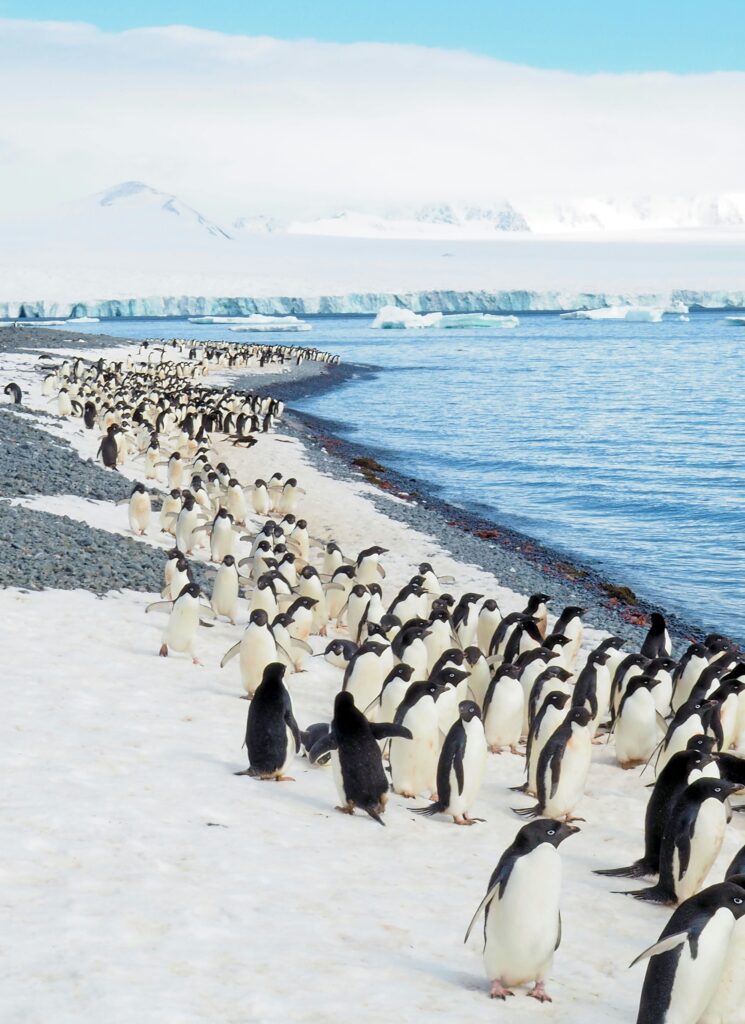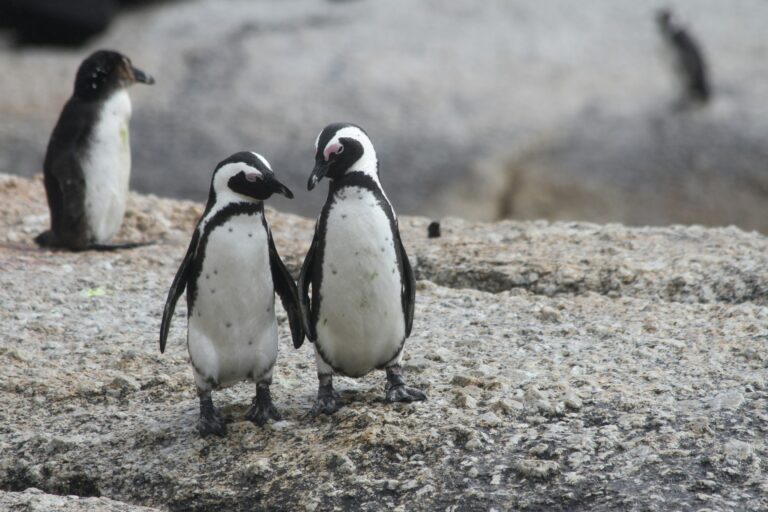Penguins are undoubtedly among the most captivating creatures on our planet, known for their distinctive waddle and adorable antics. However, beyond their charming exterior lies a story of resilience and adaptation to some of the most unforgiving environments on Earth. In this article, we delve into the remarkable world of penguins, exploring how these flightless birds not only survive but thrive in the world’s harshest conditions.
Physical Adaptations
Penguins are marvels of evolution, perfectly adapted to their aquatic lifestyle in some of the harshest environments on Earth. Their physical characteristics have evolved over time to optimize their survival in both the frigid waters of the Antarctic and the more temperate climates of the southern hemisphere. Understanding these adaptations sheds light on how these charismatic birds thrive in their challenging habitats.
Streamlined Bodies
One of the most noticeable physical adaptations of penguins is their streamlined bodies. Penguins have a fusiform shape, which means they are tapered at both ends, similar to torpedoes. This sleek, hydrodynamic body shape allows them to move swiftly through the water with minimal resistance. Their streamlined bodies reduce drag, enabling them to navigate the ocean currents efficiently and catch prey with precision.
Insulating Feathers
Another essential adaptation of penguins is their insulating feathers. Penguins have two types of feathers: outer feathers and down feathers. The outer feathers are waterproof and help repel water, keeping the penguins dry while swimming. Meanwhile, the down feathers are soft and fluffy, providing excellent insulation against the cold. This dual-layered feather structure traps a layer of air close to the penguin’s body, creating a thermal barrier that helps conserve body heat in freezing waters.
Flipper Adaptations
Penguins’ flippers are highly modified wings that have evolved for swimming rather than flying. These flipper adaptations play a crucial role in their aquatic lifestyle. Unlike flying birds, penguins have short, stiff wings that act as powerful paddles underwater. The bones in their flippers are dense and heavy, which enhances their diving abilities by reducing buoyancy and allowing for greater control and maneuverability in the water.
Countercurrent Heat Exchange
Penguins have a unique physiological adaptation known as countercurrent heat exchange. This mechanism helps them retain body heat and prevent heat loss while swimming in cold waters. Blood vessels in their flippers and legs are arranged in close proximity, allowing warm arterial blood flowing towards the extremities to transfer heat to the cooler venous blood returning to the body core. This efficient heat exchange system minimizes heat loss through the extremities, enabling penguins to maintain a stable body temperature even in icy waters.
Adaptations for Underwater Vision
In addition to their physical adaptations for swimming, penguins also possess specialized features for underwater vision. Their eyes have evolved to function optimally in low-light conditions and underwater. Penguins have large, flattened corneas and lenses that enable them to see clearly underwater. Additionally, they can constrict their pupils to reduce the amount of light entering their eyes, which helps them hunt for prey at varying depths in the ocean.
Behavioral Adaptations
Penguins exhibit fascinating social behaviors that contribute to their survival and reproductive success in their harsh environments. Understanding these behaviors sheds light on their complex social dynamics and cooperative strategies for survival.
Huddling and Communal Nesting
One of the most remarkable behavioral adaptations of penguins is their tendency to huddle together for warmth and protection. Huddling behavior is particularly crucial during harsh weather conditions, such as blizzards or extreme cold, when maintaining body heat is essential for survival. By forming tight-knit groups, penguins minimize heat loss and create a microclimate that helps them withstand the freezing temperatures. Additionally, penguins engage in communal nesting, where multiple individuals gather together to build nests in colonies. This communal nesting behavior provides added protection against predators and helps conserve body heat during incubation and brooding periods.
Feeding Habits and Hunting Strategies
Penguins are primarily carnivorous birds, with their diet consisting mainly of fish, squid, and krill. Their feeding habits and hunting strategies are finely tuned to their aquatic lifestyle and the availability of prey in their marine habitats. Penguins use a variety of hunting techniques, depending on the species and the type of prey they target. Some species, like the adept hunters such as the Emperor penguins, rely on diving to great depths to pursue fish and squid. They use their streamlined bodies and powerful flippers to propel themselves underwater with remarkable agility, catching prey with precision. Other species, such as the Chinstrap penguins, may feed closer to the surface, using their agility and swimming speed to chase down schools of fish or catch drifting krill. Penguins also employ cooperative hunting strategies, where they work together to corral and capture prey more efficiently. These cooperative behaviors often involve coordinated movements and vocalizations to communicate and coordinate their actions effectively.

Reproduction and Parenting
Penguins have developed remarkable reproductive and parenting behaviors that are essential for the survival of their offspring in the challenging environments they inhabit. Understanding these aspects of penguin biology provides insights into their complex social structures and breeding strategies.
Breeding Cycles and Mating Rituals
Penguins typically have well-defined breeding cycles that coincide with the annual changes in their environment. For many species, breeding begins with the arrival of spring or early summer, when conditions are more favorable for nesting and raising chicks. Mating rituals among penguins often involve elaborate displays and vocalizations to attract mates and establish pair bonds. These rituals can vary between species but often include courtship dances, preening, and vocal calls. Once pair bonds are formed, penguins engage in monogamous relationships for the duration of the breeding season, although some species may mate for life.
Parenting Behaviors
Penguins are known for their devoted parenting behaviors, which play a crucial role in the survival of their chicks. Shared incubation is a common practice among many penguin species, where both parents take turns incubating the eggs to ensure they remain warm and protected. This shared responsibility allows penguins to forage for food without leaving the eggs vulnerable to predators or the elements for extended periods. After hatching, both parents continue to play active roles in caring for the chicks, including feeding them regurgitated food and keeping them warm and sheltered in the nest. Penguins demonstrate remarkable coordination and cooperation in raising their offspring, with both parents working together to ensure the chicks receive the care and nourishment they need to thrive.
VIDEO CREDITS BBC EARTH
FAQs
Q. What are some key adaptations that enable penguins to survive in harsh conditions?
A. Penguins have several adaptations that help them thrive in extreme environments. These include:
- Dense feathers that provide insulation against the cold.
- A layer of fat beneath their skin for additional insulation and buoyancy.
- Counter-current heat exchange systems in their legs to minimize heat loss.
- Streamlined bodies and flipper-like wings for efficient swimming.
Q. How do penguins find food in icy waters?
A. Penguins are skilled hunters, relying primarily on their keen eyesight to locate prey such as fish, squid, and krill. They use their streamlined bodies and powerful flippers to propel themselves through the water at high speeds, allowing them to chase and catch their prey.
Q. What challenges do penguins face from predators?
A. Penguins face threats from both land and sea predators. On land, they may be preyed upon by skuas, gulls, and sea lions. In the water, they must avoid predators such as seals, sharks, and orcas. However, their agility and group behavior, such as forming tight huddles, help to minimize the risk of predation.
Q. How do penguins protect their eggs and chicks?
A. Penguins employ various strategies to protect their eggs and chicks from predators and the elements. They build nests from rocks, pebbles, or vegetation to provide shelter and insulation. Both parents take turns incubating the eggs and feeding the chicks, ensuring their survival. Additionally, adult penguins may form creches, where multiple chicks are grouped together for safety while their parents forage for food.
Q. How do penguins communicate with each other?
A. Penguins use a combination of vocalizations, body language, and displays to communicate with each other. Vocalizations range from loud calls to soft coos, which are used for various purposes such as locating mates, establishing territory, and signaling danger. Body language, including posture and movements, also plays a crucial role in communication among penguins.
Conclusion
In the face of adversity, penguins stand as a testament to the power of adaptation and resilience. From their physical attributes to their intricate social structures, every aspect of their existence is finely tuned to conquer the challenges of their harsh environments. As we continue to witness the impacts of climate change and human encroachment on their habitats, it is imperative that we take action to protect these remarkable creatures. By safeguarding the future of penguins, we not only preserve a beloved symbol of the Antarctic wilderness but also honor the delicate balance of life on our planet.
UP NEXT
The Impact of Ocean Conservation on Coastal Indigenous Livelihoods



